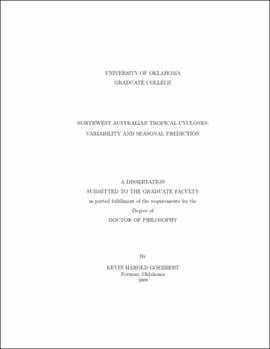| dc.description.abstract | Global teleconnections, involving geopotential height, air temperature, and sea surface temperature, are found for the interannual variability of tropical cyclone (TC) activity in Northwest-Australian (NWAUS) basin of the Southeast Indian Ocean (105-135° E). The NWAUS basin averages 5.5 TCs per year, 42 TC days, and 3 TC landfalls. Additionally, a wavelet analysis yields wavelet power maximum in the 4-6 year and the decadal time periods for both yearly TC frequency and TC days. To identify significant correlates, the global atmospheric and oceanic parameters mentioned above were correlated with the TC frequency and TC days from the Woodside Petroleum Ltd. TC data set. Large correlations were obtained between the NWAUS TC frequency and the following variables: Apr-Jun 700-hPa geopotential heights over North America (r ~ -0.64), May-Jul 850-hPa geopotential heights over the south Indian Ocean (r ~ 0.60), May-Jul 850-hPa air temperature (r ~ -0.63), Jun-Aug 925-hPa geopotential heights over the south Atlantic Ocean (r ~ -0.65), and Jun-Aug 925-hPa geopotential heights over the Eastern Pacific Ocean (r ~ -0.59). The collinearity among the five correlates are generally less than magnitude 0.4. Additionally, large correlations were obtained between the NWAUS TC days and the following variables: Jan-Mar 100-hPa v-component of the wind over the Southern Pacific Ocean (r ~ 0.52), Apr-Jun 850-hPa geopotential heights over North America (r ~ -0.58), and Jul-Sep 1000-hPa geopotential heights over the South Altanic Ocean (r ~ -0.7). These variables can be utilized as seasonal predictors for the upcoming TC season in terms of frequency and days with a lead-time of at least three months for TC frequency and two months for TC days. This set of seasonal predictors includes, intra-basin, inter-basin, and cross-hemispheric regions, unlike previous Australian TC activity studies, which stress the primacy of ENSO. Here it is noted that the traditional Nino 3.4 and Nino 4 regions were not highly correlated with the NWAUS TC activity (< magnitude 0.5). No local predictors based on SST, geopotential height, or air temperature resulted from the correlation analysis. The predictors are used in a multiple linear regression model for forecasting the coming seasons number of TCs and TC days. Finally, both prediction schemes are then compared to forecasts made using persistence, climatology, and random forecasts to determine if they perform better than these reference forecasts. | |
